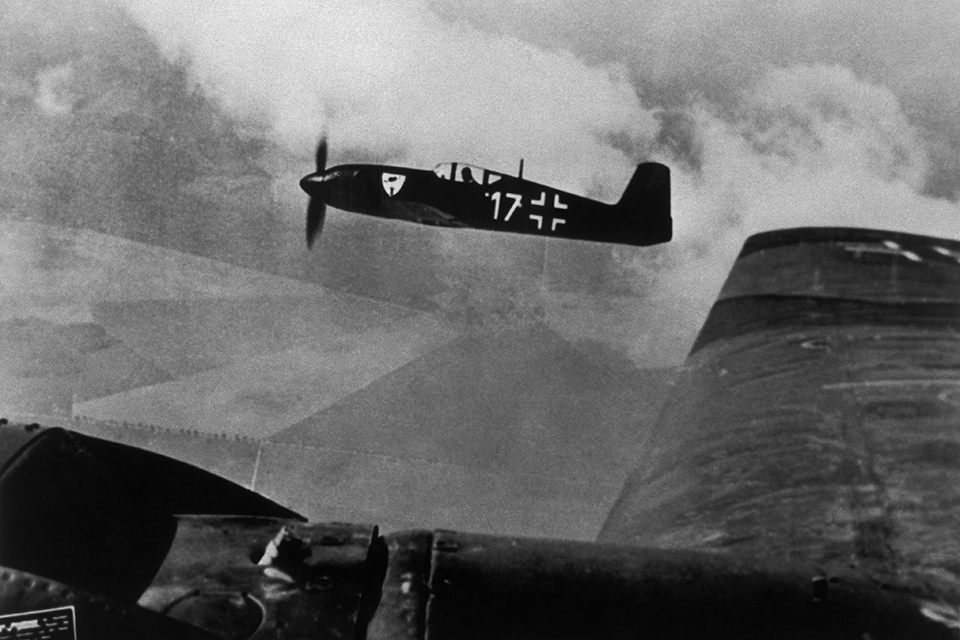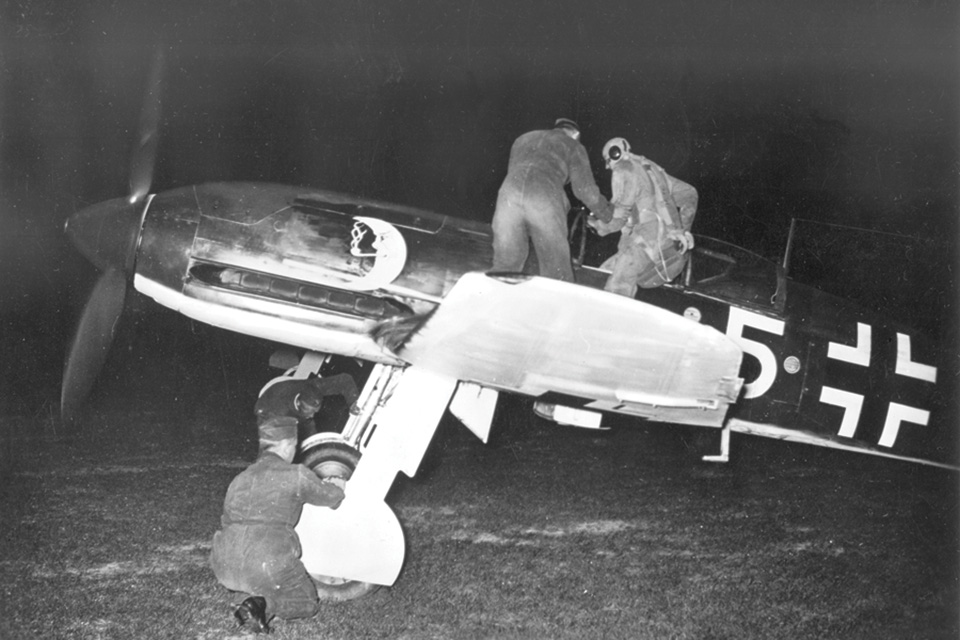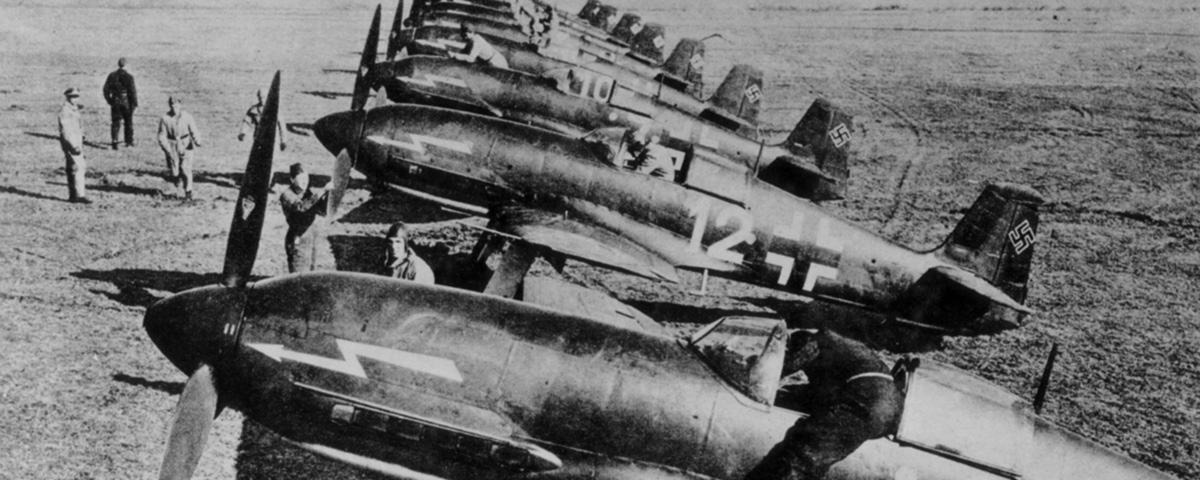A popular PowerPoint presentation that recently made the rounds via e-mail consisted of photos purporting to show equipment of the Chinese People’s Liberation Army Air Force. There are stealth fighters and lookalike B-2 bombers, quasi-Harriers and Black Hawk helicopters, Sukhoi clones and MiG-29 knockoffs—many in numbers so vast the parked rows stretch halfway to the horizon. The Chinese air force is indeed huge—third largest in the world, after the U.S. and Russia—but the computer skills of the propagandist are apparent in some of these too-obviously Photoshopped and computer-generated images.
Back in the bad old days of World War II, all it took to fool the gullible was a dozen leftover fighters nobody knew what to do with, a camera and a few good PR men (including Josef Goebbels). Before the war began, in the mid-1930s, Adolf Hitler’s new National Socialist government needed a modern fighter for its nascent Luftwaffe. Several German companies, including Heinkel and Messerschmitt, offered proposals and prototypes. Messerschmitt won the contest with the design that would be known as the Bf-109, but Heinkel was a close contender with its He-112, a gull-wing single-seater that initially had an open cockpit but soon got a sliding canopy. The He-112 was a handsome bird, though it was slightly slower than the Bf-109 and couldn’t turn quite as well. While the Heinkel was easier to handle on the ground—it had relatively wide-set main wheels rather than the Messerschmitt’s little olives-on-toothpicks bipod—the 109 got the nod.
But Ernst Heinkel wasn’t about to cede victory to his rival Willy Messerschmitt. It soon was time to come up with a successor to the Bf-109, since any smart air force procurement office asks for a follow-on the minute a major design goes into service. Heinkel proposed the He-113—soon renamed the He-100, since Ernst was superstitious about 13s.

The Reich Air Ministry assigned not only constructor prefixes such as Me-, Fw- and He- but also apportioned to each builder specific model numbers, so that nobody but Focke Wulf, for instance, could make an airplane designated -190. Under the German system, it would have been impossible to have both a P-47 and a B-47, or a PT-17 and a B-17. The model number 100 had already been assigned to Fieseler, but Heinkel prevailed, and the He-100 went into prototype production.
It was a splendid airplane that looked a little like an He-112 rework due to its similar gull wings, but in fact was a totally new, extremely sophisticated design. The He-100 featured a compact airframe wrapped around a Daimler-Benz 601 V-12 engine, and reached surprising speeds because of its excellent aerodynamics—due in part to its complex evaporative surface engine cooling system.
Heinkel loved evaporative cooling, which was something of a 1930s fad thanks to its having been used on several Schneider Trophy racers. A pressurized engine cooling system allowed the coolant to stay liquid even after reaching temperatures higher than the normal boiling point. When it was then released into a network of tubing just under the leading edges of the wings, the coolant instantly turned to steam, after which it was condensed by the cold airflow and returned to the engine as water. The thinking behind this: Raising the temperature of water 60 degrees from 180 to 240 Fahrenheit absorbs far more energy than raising the same quantity of water 60 degrees from 150 to 210.
Heinkel decided to stick it to Messerschmitt by setting speed records with the He-100—raising the 100-kilometer closed-course record to 394.4 mph and then setting a world absolute speed record of 463.92 over a three-kilometer straight course. The closed-course racer was a stock 1,175-hp He-100, but the absolute-record aircraft was a ringer, with clipped wings, a slim canopy and a special Daimler-Benz engine running on a methyl alcohol mix that could put out 1,800 hp steadily and 2,770 for brief periods—a 12-cylinder grenade intended to last only as long as it took to set the record. After its high-speed flight, the plane’s shortened wings and slick canopy were combined with a normal He-100 fuselage and a stock DB 601 engine, then displayed at the Deutsches Museum in Munich, leading the world to assume that even ordinary He-100s could reach speeds not actually achieved by production aircraft until the P-51D Mustang and F4U Corsair entered service years later.
But the Luftwaffe still didn’t want the He-100. Whatever the category, the Air Ministry preferred to have a single type rather than support multiple models, and the Bf-109 remained its fighter of choice until the Focke Wulf Fw-190 came along in substantial numbers in 1942. Daimler-Benz’s production of DB 601 engines remained slow as well, and there weren’t enough V12s to be given to secondary builders. DB 601 production was thus totally devoted to Messerschmitt, for the 109 and the 110 twin-engine escort fighter.
Heinkel sold a few He-100s to the Japanese and the Soviets, and some say the Kawasaki Ki-61 and Yakovlev Yak-9 owe much to the Heinkel’s design and engineering. (Nobody wanted to use the complex and vulnerable evaporative cooling system, though, and eventually even Heinkel gave up and mounted a semiretractable coolant radiator on late-production He-100D-1s.) Hitachi planned to license-build He-100s for the Japanese navy, but never got any further than constructing a factory—which today is probably cranking out flat-screen TVs.
Oddly enough, Heinkel kept 12 He-100s for use as a private air force, flown by company test pilots to defend its factory outside Rostock. None ever flew with the Luftwaffe, nor did Allied bombers ever challenge the Rostock bodyguards.
And it’s here that we finally return to propaganda involving the He-100. Somebody got the bright idea of using Heinkel’s dozen unwanted He-100s to stage a substantial piece of tomfoolery—probably not Propaganda Minister Goebbels himself but one of his underlings, though Goebbels enthusiastically bought into the idea. Here’s the deal: Take the 12 He-100s, already feared by the RAF because one had ostensibly set a world speed record, and paint them like operational Luftwaffe fighters, with squadron nose art, Nazi insignia and big buzz numbers on the fuselages. Photograph them in a variety of situations—running up for a night flight, being preflighted for a scramble, in flight, dispersed among disguised revetments on a grass “forward airstrip,” parked in a long row ready for combat. Announce that they represent the new Luftwaffe frontline super-fighter, the “He-113.” Oh, and change the paint schemes and insignia every time you photograph the decoys.

Popular lore has it that the phony fighters were photographed at a variety of German air bases and even in Norway and Denmark, but existing photos reveal that in fact all the propaganda snaps probably were done at Rostock, with Heinkel employees posing as ground crew and pilots, and the change-the-disguise paint booth close by. Nothing in the photos shows any distinctly differing “Luftwaffe air bases.” Did it work? You bet. Classified documents reveal that for three years RAF analysts were convinced the Luftwaffe was holding back squadrons of He-113s. It may be that during the Battle of Britain this actually worked in the RAF’s favor: Air Marshal Hugh Dowding feared that He-113s were about to be deployed, and he was convinced that some of his pilots had already fought them. That probably contributed to his insistence on always holding back reserves, which turned out to be one major factor in the RAF’s victory over the Luftwaffe in the summer of 1940.
The He-113 photos were published in German newspapers and the official Luftwaffe magazine, Der Adler, also leading civilians to believe their air force had a potent new weapon. According to one erroneous report, the mythical super-fighter even made an appearance at Pearl Harbor. Late on December 7, 1941, intelligence officer Lt. Col. T.H. Davies sent a message, “One plane brought down in the south sector was identified as a German made Heinkel 113.” Throughout the war, both RAF and USAAF bomber and fighter pilots would report confrontations with the He-113. What had they actually seen? Perhaps it was simply a matter of misidentifying a later-model Me-109 or even a Spitfire, but probably not. Heinkel had sold 17 of its He-112s, the He-100’s predecessor, to Spanish Nationalists during the Spanish Civil War. When that war ended, Germany retrieved the 15 that were still flyable and put them into frontline service, where they fought until 1945.
Heinkel’s Mythical Super-Fighter originally appeared in the May 2009 issue of Aviation History. Subscribe here today!





